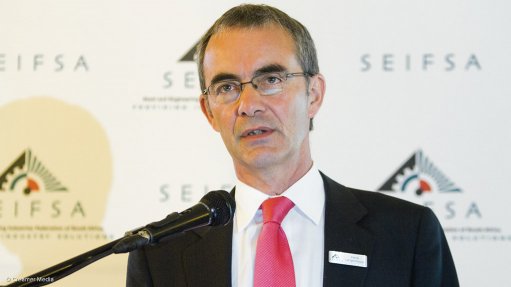
Seifsa economist Henk Langenhoven
Photo by: Duane Daws
Price instability and weak performance have hammered South Africa’s manufacturing sector.
All major sectors under the manufacturing umbrella – from paper and publishing and clothing and textiles, to chemicals, automotive, food and metals – were performing below full capacity, Steel and Engineering Industries Federation of Southern Africa (Seifsa) chief economist Henk Langenhoven said at the Bureau for Economic Research conference, in Stellenbosch, this week.
He added that there was also “incredible instability” in commodity prices, which made planning “almost impossible”.
Export demand was currently very weak in many manufacturing subsectors.
“The trends in metals and engineering are linked to international shocks in commodity prices,” said Langenhoven, noting that there was much lower demand both internationally and domestically, which had made the industry “hugely unstable”.
The slowdown in exports was taking its toll on basic iron and steel products in particular, where 68% of production was exported. General purpose machinery, of which 74% was exported, was also under pressure, while 43.9% of motor vehicles were destined for export.
“South Africa is heavily dependent on exports, so what happens in China and Europe has a material impact on us,” Langenhoven stressed.
China’s demand for manufactured goods had slowed down considerably, causing much of the pain being felt in the South African manufacturing industry, as well as those of other countries.
Inventories were rising. “Companies are sitting with so much steel they don’t know where to walk in their yards,” said the Seifsa economist.
Rising costs had also had a major impact on investment, while jobs were being lost. Some industries had shed jobs over many years. Employment in the textiles and clothing industry was down by 42% compared with 2000, while employment in the food and beverages and tobacco subsectors had declined by 8%.
Langenhoven said South Africa’s manufacturing industry had not recovered since the financial crisis in 2008. There was a small hiatus in 2010, with a domestic boom ahead of the 2010 FIFA World Cup, but this ended.
He lamented the fact that a lot of “repetitive” manufacturing in the country had closed down.
“We are importing components of valves, when we used to make the whole valve here. We export catalytic converters to Germany. They put them in the engine and then export them back to South Africa.”
He said the South African market was too small to sustain major technologically advanced investment.
“If we don’t find our niches and understand the dynamics around them, it’s going to be dire,” he warned.
He said manufacturing should not be seen as one big industry, but rather as very diverse industries, with different policy needs.
“It’s wrong to think of manufacturing as this homogenous thing. It has policy implications. Government policy must take the dynamics of each industry into account.”